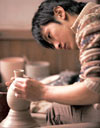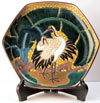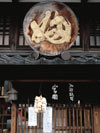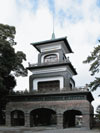| Web Japan > NIPPONIA No.36 > Japan Travelogue |
|
|
|
NIPPONIA No.36 March 15, 2006 |
|
Japan Travelogue Kanazawa |
|
|
(10) |
Toshioka Koichiro says he used to play in the potter's studio here when he was a young boy. |
|
|
|
|||
|
|
(11) |
A large plate decorated boldly with the five trademark colors of Kutani ware. Diameter, 32 cm. |
|
|
|
|||
(12) |
Gojukken Nagaya Storehouse at Kanazawa Castle. It was built to store weapons and to serve as part of the castle wall at the same time. It was reconstructed in 2001. |
||
|
|
|||
|
|
(13) |
Kanazawa produces more gold leaf than anywhere else in Japan. It would be hard to imagine maki-e lacquer ware or byobu screens without their decorative sprinkled gold or gold leaf. The thickness of the gold leaf? Some is as thin as one ten-thousandth of a millimeter! (Photo taken at Hakuichi Honten Hakkokan Gold Leaf Center) |
|
|
|
|||
|
|
(14) |
Clay walls line narrow lanes, where middle-ranking samurai once lived.
The area, called Naga-machi Buke-yashiki Ato, is a quiet place today. It is a short walk to the west of the Korinbo shopping district. |
|
|
|
|||
|
|
(15) |
Miyata, in the Higashiyama district, makes and sells fu (a bread-like substance made from steamed wheat gluten, which contains valuable protein). Fu is an almost indispensable element in Kaga cuisine.
|
|
|
|
|||
|
|
(16) |
Kenroku-en Garden attracts more than 2 million visitors a year. Many are drawn to this spot beside Kasumi-ga-ike Pond, where a stone lantern adds charm to the scene. On the other side of the water, yuki-tsuri rope work supports the tall pines to protect them from heavy snowfalls.
|
|
|
|
|||
|
|
(17) |
Bizan Shrine preserves the memory of Maeda Toshiie, the family ancestor of a long line of feudal lords who ruled the Kaga domain. The surprising design of Shinmon Gate (foreground) combines elements of Japanese and Western architecture. |
|
|
|
|||
|







